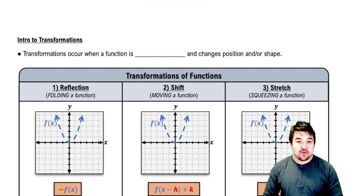Table of contents
- 0. Functions7h 52m
- Introduction to Functions16m
- Piecewise Functions10m
- Properties of Functions9m
- Common Functions1h 8m
- Transformations5m
- Combining Functions27m
- Exponent rules32m
- Exponential Functions28m
- Logarithmic Functions24m
- Properties of Logarithms34m
- Exponential & Logarithmic Equations35m
- Introduction to Trigonometric Functions38m
- Graphs of Trigonometric Functions44m
- Trigonometric Identities47m
- Inverse Trigonometric Functions48m
- 1. Limits and Continuity2h 2m
- 2. Intro to Derivatives1h 33m
- 3. Techniques of Differentiation3h 18m
- 4. Applications of Derivatives2h 38m
- 5. Graphical Applications of Derivatives6h 2m
- 6. Derivatives of Inverse, Exponential, & Logarithmic Functions2h 37m
- 7. Antiderivatives & Indefinite Integrals1h 26m
0. Functions
Transformations
Problem 9
Textbook Question
How do you obtain the graph of y=f(x+2) from the graph of y=f(x)?
 Verified step by step guidance
Verified step by step guidance1
Understand that the expression y = f(x + 2) represents a horizontal transformation of the function y = f(x).
Recognize that adding a positive number inside the function's argument, such as x + 2, results in a horizontal shift to the left.
To graph y = f(x + 2), take each point (x, y) on the graph of y = f(x) and shift it 2 units to the left, resulting in the new point (x - 2, y).
Ensure that all points on the original graph are shifted consistently to maintain the shape of the graph.
Check the new graph to confirm that it accurately represents the function y = f(x + 2) by verifying a few key points and their transformations.
Recommended similar problem, with video answer:
 Verified Solution
Verified SolutionThis video solution was recommended by our tutors as helpful for the problem above
Video duration:
5mPlay a video:
Was this helpful?

 5:25m
5:25mWatch next
Master Intro to Transformations with a bite sized video explanation from Nick
Start learningRelated Videos
Related Practice


